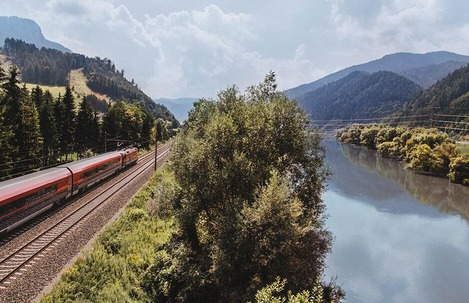
Experience more.
When we say "experience more", we mean all the many dimensions of human travel: arriving, living and learning.
In 2030, trains will speed from Vienna to Klagenfurt in just 2 hours and 40 minutes and from Graz to Klagenfurt in 45 minutes. Covering a total of 470 km, they will pass through numerous new railway stations and through the Semmering and the Koralpe mountains at the highest of speeds. And when it comes to more "experiences" - just wait until Austria’s new Southern Line opens!
The future of travelling and transport
The Southern Line is one of the largest and most spectacular infrastructure projects of the coming decade. 200 kilometres of railway lines will be modernised and 170 kilometres newly built. This project has already led to the employment of 5,000 people and is expected to create 15,000 more jobs in the future. This new line will allow millions of tonnes of goods to get to their destination faster and for less money.
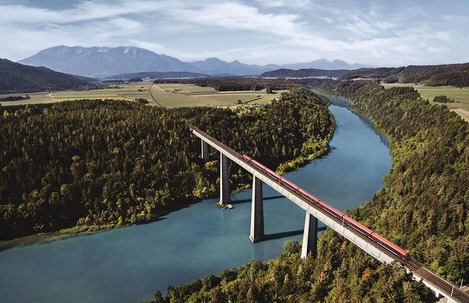
Increased mobility
Fewer detours
3.5 million people live in the Southern Line’s commuter belt. They want to be mobile and enjoy internationally imported goods from all around the world. Austria’s largest creator of railway infrastructure, ÖBB-Infrastruktur AG, is dedicated to fulfilling this wish. One of its most important tasks is to expand the North-South railway connection. In concrete terms, this translates into more than a quarter of a century of hard work and dedication for 170 kilometres of new and 200 kilometres of modernised railway lines.
More Railway
Less road use
The Southern Line includes: the expansion of the Northern Line, the modernisation of the Marchegger Ostbahn (Vienna-Bratislava route), the new Vienna Main station, the Freight Centre Vienna South, the Pottendorfer line (soon-to-be a high-performance line), the Semmering Base Tunnel, eight modernised railway stations between Bruck and Graz, the revamped Graz Main Station and the 130-km Koralm Line. Together, this mix will lay the foundation for future-orientated passenger and freight transportation.

More Possibilities
Fewer restrictions
In addition to some 37 million passengers per year on the southern line, 22 million tonnes of goods are transported by ÖBB along it and over the country's borders to Southern European destinations, such as the Adriatic ports. An extended, high-performance line allows these goods to reach their destination even faster. Thanks to its new, large tunnel, the Semmering is no longer a lengthy, expensive obstacle and the new Koralm Line bypasses the narrow Mur Valley and the steep Neumarkter Sattel.
More Efficiency
Less consumption
This straightened line enables freight trains to carry heavier loads for longer periods of time, with just one traction unit to boot. This decreases road traffic, protects the environment, and drastically reduces transport costs. Each tonne of freight that is transported by train rather than truck decreases carbon dioxide emissions thirtyfold.
More Freedom
Shorter travel times
Every year, 34 million passengers travel with Austria’s long-distance trains – twice as many as before the turn of the millennium. People leave their cars at home and travel by train if attractive connections are available. Proof of this could be seen after the expansion of the 300-km-long Western Line between Vienna and Salzburg. We expect the same development for the approximately 470-km-long Southern Line (including the Northern Railway), whose commuter belt is home to more people than the Western Line.
More Europe
Fewer borders
ÖBB-Infrastruktur AG is working on more than 100 large and small scale projects along the so-called Baltic-Adriatic Corridor from north to south. Stretching between the Baltic and Adriatic seas, this area covers a total of 1,700 kilometres. The corridor is both favoured and co-financed by the European Union. For Austria, the inclusion of the Southern Line in this far-reaching, trans-European connection means valuable access to emerging economies and the most important seaports.
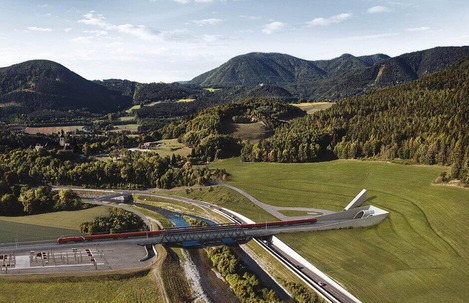
New Routes
The Southern Line at a Glance
The sub-projects are lined up like pearls on a string, covering a total distance of 470 kilometres from the northern to the southern state borders. The goal: better connections between Austria and the neighbouring countries, between the four Austrian states and between the three state capitals.
Southern Line
- Northern Line Anticipated operational start 2026
- Extension Marchegger Ostbahn 2015 - 2025
- Vienna Main Station Fully operational December 2015
- Freight Centre Vienna South Operational start 2016
- Pottendorfer Line Operational Start 2023
- Semmering Base Tunnel Completion 2030
- Modernised Railway Stations and increased quality 2013 - 2027
- Graz Main Station New since October 2015
- Koralm Line Operational start 2025
01 Northern Line
More Connections – Fewer Borders Bringing Europe closer together
18 new train stops on the way through the wine district
ÖBB-Infrastruktur is developing the Northern Line across 66 kilometres between the Vienna Süßenbrunn station and Lower Austria’s Bernhardsthal station. This will make the railway line along the Czech border faster and safer. Busy railway crossings will be closed and replaced with underpasses and overpasses; the 18 train stops will be remodeled to become barrier-free and equipped with rail-free access to the platforms.
Read more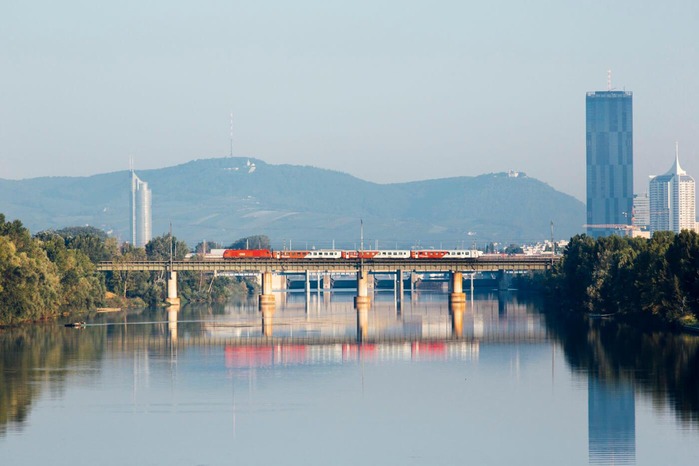
At 160 km/h to Prague
The goal is to bring Austria and the Czech Republic even closer together. Starting 2026, Northern Railway trains will race back and forth at 160 km/h. Passengers will be able to travel from Vienna to the South Moravian village of Breclav in just an hour; the journey to Prague will take a mere 3 hrs 45 min, an entire half-hour faster than it is now. Freight transport will equally benefit from this line expansion.
Gdansk and Trieste are around the corner
Planning for the new Northern Line has begun. The first step will be an environmental impact assessment, i.e. the assessment of possible effects on mankind, animals, and the environment. At the same time, discussions and negotiations will be conducted with our Czech neighbours in order to coordinate project activity. The Baltic-Adriatic Corridor between Swinoujscie/Gdansk and Koper/Trieste/Ravenna is one of nine Core Network Corridors building the backbone of the European transport routes.

"A modernised northern line will bring us even closer to our neighbours in the North."
Gernot Scheuch Project Manager Northern line
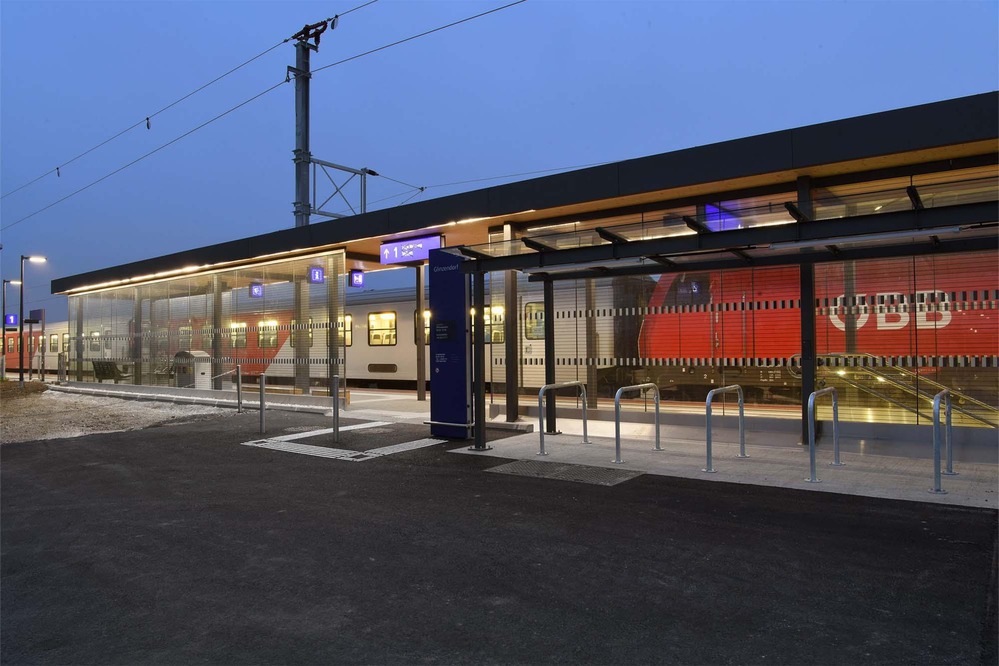
02 Extension Marchegger Ostbahn
Nine modernised stations, more Park&Ride and Bike&Ride Austria’s longest straight track is made ready for the future
Comfortable rail travel
Around 37 kilometres of railway line between Vienna and Marchegg are being modernised and electrified in order to allow rapid and safe travel. The majority of the line through the Marchfeld, namely 32.5 kilometres, goes straight through the countryside, making it the longest straight line in the Austrian railway network. This allows a maximum speed of 200 km/h in the future. The previously single-track diesel line will become a double-track, electrified high-performance line. 90 kilometres of track will be re-laid, 9 stations modernised, 14 railway crossings abandoned and replaced by underpasses or overpasses. On the Slovakian side, the upgrading project is being continued by the Slovakian State Railways.
Read moreAbschnittsweise Realisierung
Nach der erfolgreichen Umweltverträglichkeitsprüfung 2014 starteten die Modernisierungsmaßnahmen 2015 am starteten die Modernisierungsmaßnahmen 2015 am Bahnhofs Marchegg. Von 2016 bis 2018 wurde am Teilabschnitt Wien Stadlau bis Wien Aspern Nord gearbeitet. In der euen Mobilitätsdrehscheibe Wien Aspern Nord ist die ÖBB-Strecke mit der U-Bahnlinie U2 verknüpft. Der in Niederösterreich gelegene Streckenteil bis Marchegg wurde bis 2023 elektrifiziert und zweigleisig errichtet. Der weiterhin eingleisige Abschnitt von Marchegg bis zur slowakischen Staatsgrenze wird in Zusammenarbeit mit den Slowakischen Staatsbahnen 2025 elektrifiziert. Die Bahnhöfe Raasdorf, Glinzendorf, Siebenbrunn-Leopoldsdorf, Untersiebenbrunn, Breitensee und Schönfeld-Lassee erhielten ein modernes, neues Erscheinungsbild. Bis 2025 ist die gesamte Marchegger Ostbahn durchgehend zweigleisig ausgebaut.
03 Vienna main station
More than a railway station City, campus, Viennese districts and European station
A hub in the European transportation network
On 109 hectares of land, the full Vienna main station project is one of the largest building projects of the last decade in the city and country. It brings together a new station building with the development of a whole district. On what was once the southern station, ÖBB-Infrastruktur built a modern through station from 2010 to 2015. Trains can arrive and immediately leave again from all directions. The Austrian capital has become even more of a central hub than before - not just for regional and national traffic but also now on the trans-European rail network. The large building flooded with light with a diamond shaped roof, which is now known as the ‘Station City Vienna Main Station’, in which there are around 90 shops and pubs, invites travellers, local and neighbours to stay and have a look.
Read more
Faster Connections between Western Austria and the Airport
Since December 2015 all tracks have come together at the Vienna Main Station. All cross-border European and inland Austrian express trains now run in and out of the station, including those from the West. A train from Innsbruck, Salzburg and Linz brings passengers directly to Vienna International Airport every 30 minutes. Easy changes, short stopping times, good connections: travelling by rail is getting much easier.
A New City District for 13,000 People
All around the new main station, there will be an entire 59 hectare district in 2020. In one area, the southern ‘midsummer district’, 13,000 people have a happy home - in well thought out, energy-saving residential buildings surrounded by a seven hectare park. Trees have been planted, houses and apartments built, and kindergartens and schools already opened, making it a real urban campus. One where you can go straight to the northern part, the ‘Belvedere quarter’. Here, hotels and office buildings are reaching new heights and the ÖBB headquarter is here too. The new district will provide apartments and workplaces for 30,000 people.

"Project management is work with and for people. In the end, the contribution of each and every individual is what counts."
Judith Engel Project Manager Vienna Main Station
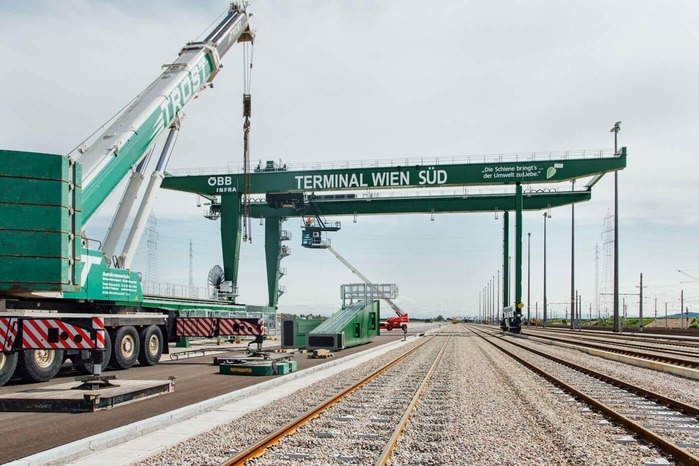
04 Freight Centre Vienna South
How to truly combine road and rail The emergence of a modern freight terminal
55 hectares and hundreds of freight containers
In the south of Vienna, in the district of Favoriten, near the industrial area of Inzersdorf, ÖBB-Infrastruktur is constructing a trading centre, otherwise referred to in the transportation industry as an ‘intermodal terminal.’ 30 kilometres of new operational tracks have been laid here, and the necessary operational buildings and access roads have been built. In fully operational mode, the 55 hectare facility will include container storage areas and heavy load gantry cranes. ‘Intermodal’ explained: Different modes of transport and traffic routes meet at one point. For example: one and the same container can be transported by train and then lorry, or vice versa. The goods do not have to be unloaded, moved and reloaded. This saves time and money.
Read more
"We are building the main station here for goods in East Austria!"
Christian Trummer Project Manager Freight Centre Vienna South
Faster transportation between Vienna and the rest of Europe
The Vienna South Freight Centre is a modern transportation hub from the Vienna region to the most important economic centres throughout Europe. Another key aspect is a good connection to the new economic region in the Balkans. Together with freight transport to the west, a high-performance network will be constructed, which will optimally connect the Vienna region to trading partners. Transport to the important seaports for international shipping is also a significant function of the freight centre. Harbours, river routes, motorways and railway stations are thus woven together to form a system.
More handling capacity
The first facility, the terminal area of the freight centre, was put into operation at the end of 2016. As part of the second facility, in 2021 the logistic depot was finished. Currently it is possible to handle 210,000 Intermodal Transport Units (ITU) per year. With further expansion the handling capacity will grow up to 315,000 ITU. On top of that there will be further warehouse capacity of 940 TEU (Twenty-foot Equivalent Unit). The second expansion phase will be finished by the end of 2025.
05 Pottendorfer Line
Four Tracks between Vienna and Wiener Neustadt A second southern line for commuters
Convenient, fast travel into Vienna and back home
Until 2024 ÖBB-Infrastruktur will be modernising the Pottendorfer line, a 52 kilometre long extension route on the southern line. This second route begins in Vienna Meidling and goes to Lower Austria, via Wampersdorf, a district of the eponymous area Pottendorf and on to Wiener Neustadt. It will be a modern two-track high-performance route and it is getting faster too; the trains can run at up to 200 km/h on the rails. The updated line between Vienna Meidling and Wiener Neustadt will be used by thousands of commuters on their way to work every day in the offices and shops of the capital. A large part of the railway line is already running as a two-track line and has been through the upgrade already: the section between Wampersdorf and Wiener Neustadt and - apart from one leg - the section between the station of Vienna Meidling and the new Vienna Blumental stop, which is near the existing freight centre Vienna South.
Read more
More comfort with four new railway stations
Since 2016, ÖBB-Infrastruktur has been working hard on the Hennersdorf-Münchendorf and Ebreichsdorf sections: the whole section will be expanded to be double tracked and four stations, Hennersdorf, Achau, Münchendorf and Ebreichsdorf will be completely renewed. On this section, all level crossings will be abandoned and replaced with safe overpasses and underpasses. Over the next few years, 23 new bridges and underpasses, numerous drainage systems and noise barriers 11 kilometres long will be built.

"The planning and construction work is being carried out in close coordination with the surrounding communities and the work will provide these communities with attractive train services with modern infrastructure in future."
Thomas Schöfmann Project Manager Pottendorfer Line

06 Semmering Base Tunnel
Vienna – Graz in 1 hr 50 min In the future, Semmering will be a bottleneck no more
Rapid transportation, even for heavy freight trains
The Semmering Base Tunnel goes from the Lower Austrian Gloggnitz to the Styrian Mürzzuschlag, through the Semmering massif. It is exactly 27.3 kilometres long and creates the conditions for future-orientated passenger and goods transport with its two tunnel tubes, which will be completed in 2030. The travel time for passengers from Vienna to Graz will be reduced by 50 minutes. Unlike the mountain route of the historical Semmering railway, even heavy freight trains can travel with just one traction unit on the incomparable base tunnel. One of the bottlenecks on the Baltic-Adriatic corridor is thus avoided.
Read more
"The Semmering Base Tunnel enables a new dimension of travel."
Gerhard Gobiet Project Manager Semmering Base Tunnel
The best of 13 track variations
When planning and building the Semmering Base Tunnel, a two-tube tunnel system, sensitivity is given top priority. Long before ÖBB-Infrastruktur even began with the construction, geologists and hydrologists examined the area. They examined stone and water. Even the effects on the settlement area were investigated by experts. From 13 variants, the most suitable route was selected. The undertaking involves hundreds of tasks, such as re-routing roads and flood protection. Now the tunnel is being constructed from several points. When constructing a tunnel, great care is needed every day.
The historic Semmering Train
The new tunnel takes some of the burden off of the time-honoured Semmering and Ghega railways, the first mountain railway to be declared a UNESCO world heritage site. The railway section, the viaducts, the tunnel and the station are currently being renovated and modernised to ensure that operation can be maintained. The railway is steeped in history and remains a beloved travel destination.
07 Modernised Railway Stations
Eight modernised railway stations Track-free platform access
Eight modernised railway stations and train stops
Between Bruck an der Mur and Graz, on a rail segment 53 kilometres long, ÖBB-Infrastruktur will be working until 2027 to bring eight stations and train stops up-to-date. They are exchanging rails and overhead lines, considering future right hand running and rebuilding or creating the buildings. With the display boards, ticket machines and directions system, the stations will be light and clearly arranged. They have to be prepared for what is predicted for the considerably ‘faster’ southern line: a lot more passengers.
Read more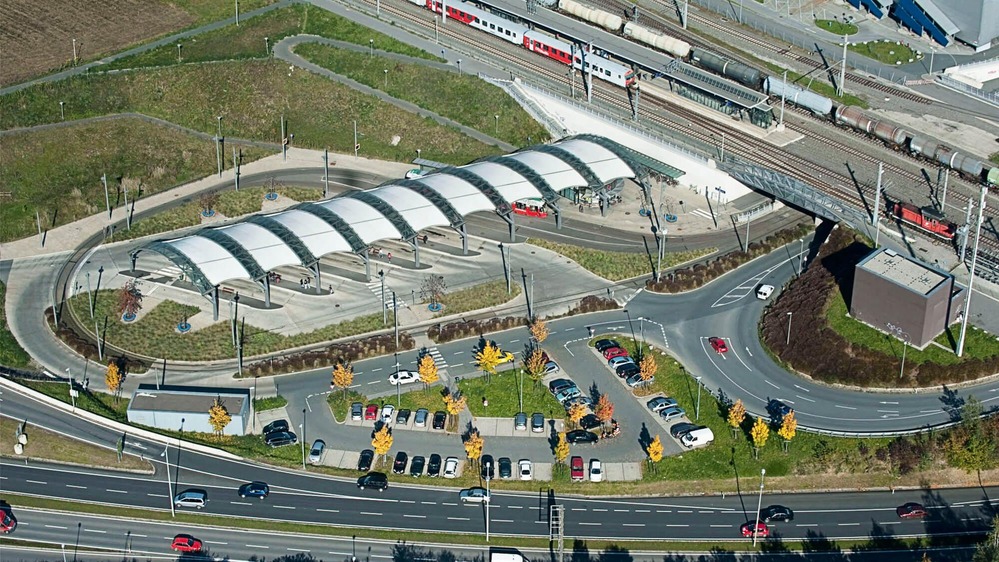
Track-free platform access
Modernisation is especially important in the area around Graz, where more trains and especially express trains will be running. Fully automatic interlocking systems have been installed for a quicker and safer combination of switches, gates and signals and another safety factor, rail-free train access, is also being brought in. Staircases and exits are thus made more suitable for wheelchair and pram access, which can now by achieved without barriers.

08 Graz Main Station
One railway station for over 40,000 people Graz will serve as a 2nd international transport hub after Vienna
Railway station reconstruction from A to Z
Day after day, 41,000 people enter Graz Main Station. They arrive or depart, wait for travellers or accompany them. With the completion of the Koralm Line in 2025, the Graz station will be more significant, for international travel too, because it is on one of the most important north-south transversals of Europe. This required a modernisation from A to Z. All of the railway systems had to be renovated and expanded. The entire project “Graz Main Station” got started in 2009 and in autumn 2015 it was completed - but it involved more than an expansion of a railway station. It involved several infrastructure projects from the ÖBB, the city of Graz, the Graz Holding and the state of Styria, as well as numerous new buildings, that were built.
Read more
"With the main station’s modern, waved roof, we have created a completely new landmark."
Klaus Schneider Project Manager Graz Main Station Overall Coordinator Koralm Line
New interlocking system and numerous service halls
While the Graz station was gradually transforming, a new passenger tunnel was built, which extended track systems with platforms and roofing, as well as a new motorail train facility with a new group of park and ride stops. In the station area, all of the facilities are now gathered together: the service hall for technical services, a service building with training workshops, a new location for Rail Cargo Austria AG, a modern electronic interlocking system and offices and car care halls. At the Graz shunting yard, ÖBB-Infrastruktur updated the rail technology and braking technology. The operation of all of this had to be modernised and accelerated to be prepared for the future.
Graz’s Lend district grows closer
With the continuous passenger tunnel in the north of the platform, Graz Main Station merges the Lend district, which was divided into an east and west section. The Graz Main Station is thus a new hub for local traffic with urban development aspects, a community project by city, state and ÖBB.
09 Koralm Line
Off to the south on 130 kilometres of new railway lines past 23 stations and through many new tunnels
Faster Connections to Southern Austria
Since 1999, the ÖBB has been building the Koralm Line in Styria and since 2001 in Kärnten, there has been a new stretch of railway 130 kilometres long. This line makes southern Austria easier to reach. South Kärnten and West Styria are easier to access now too - both regions are getting closer to the state capital, Graz and Klagenfurt.
Read more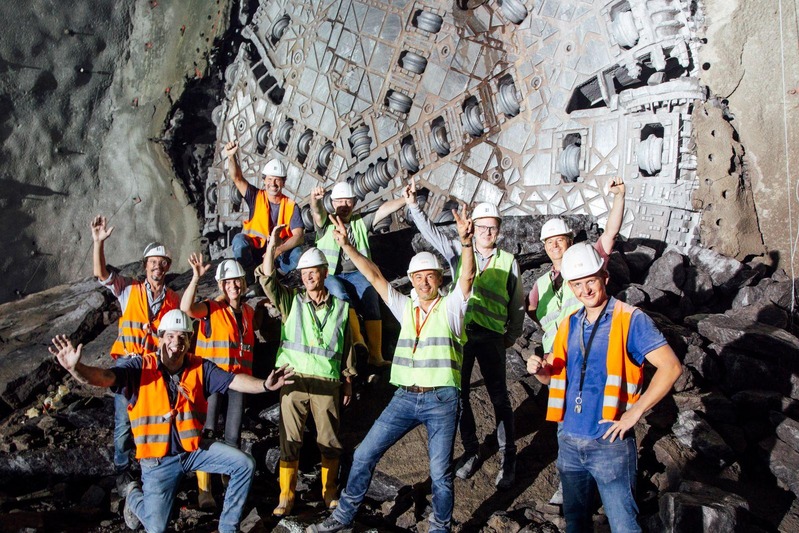
Graz – Klagenfurt in 45 minutes
This is an advantage for commuters and companies too. The Koralm Line transports people and goods more quickly, with short journey times and at short intervals. With its completion in 2025, a journey from Graz to Klagenfurt will take only 45 minutes, instead of the two hour bus journey that was previously required. People who travel from Graz to Venedig can be very pleased with a time saving of up to four hours. In future, people will be able to glide through the countryside along the whole Koralm line at up to 230 km/h.
The sixth-longest railway tunnel in the world
For a quarter of the section, the trains will travel through tunnels, the longest is the Koralm tunnel, at 32.9 kilometres long. It is the sixth longest railway tunnel in the world and connects Styria with Kärnten and the Deutschlandsberg area with the middle of the Lavant valley. At a maximum depth of 1.2 kilometres, two tunnel tubes running in parallel, each with a ten metre outer diameter, break through the Koralpe massif.
23 new and modernised stations and train stops
Along the line, eleven stations have been or are being completely modernised and twelve newly built: in Styria, the stations Kalsdorf, Werndorf and Wettmannstätten, as well as the Hengsberg stop; in the local transport hubs Don Bosco and Puntigam; in Klagenfurt, the station Klagenfurt Ebenthal. These stations are very significant, they are a guarantee for the regional use of the Koralm line: thousands of people will get on and off here and this will be to their advantage.
The Koralm Line connects Köflach with Bleiburg
The Koralm Line fits into a local railway network. It connects to the future station West Styria, in the greater St. Florian area with the Graz-Köflacher railway. The regional line Zeltweg - Wolfsberg merges into the new Lavant valley station. Other new stations: Aich/Wiederndorf, Mittlern, Kühnsdorf/Klopeiner See, Grafenstein. To open up the surrounding countryside, two more lines were modernised on the Kärnten side: the Lavant railway and what is known as the Bleiburg loop; it connects the town community of Bleiburg and the market community of Feistritz on Bleiburg to the southern line.

"With the main station’s modern, waved roof, we have created a completely new landmark."
Klaus Schneider Project Manager Koralmbahn 1

"It’s important to inform people about our projects, children just as much as adults."
Christiane Schiavinato Project Manager Koralmbahn 2

"To make sure the construction runs smoothly, every stage of work for the construction of a tunnel must be precisely coordinated."
Dietmar Schubel Project Manager Koralmbahn 3

















